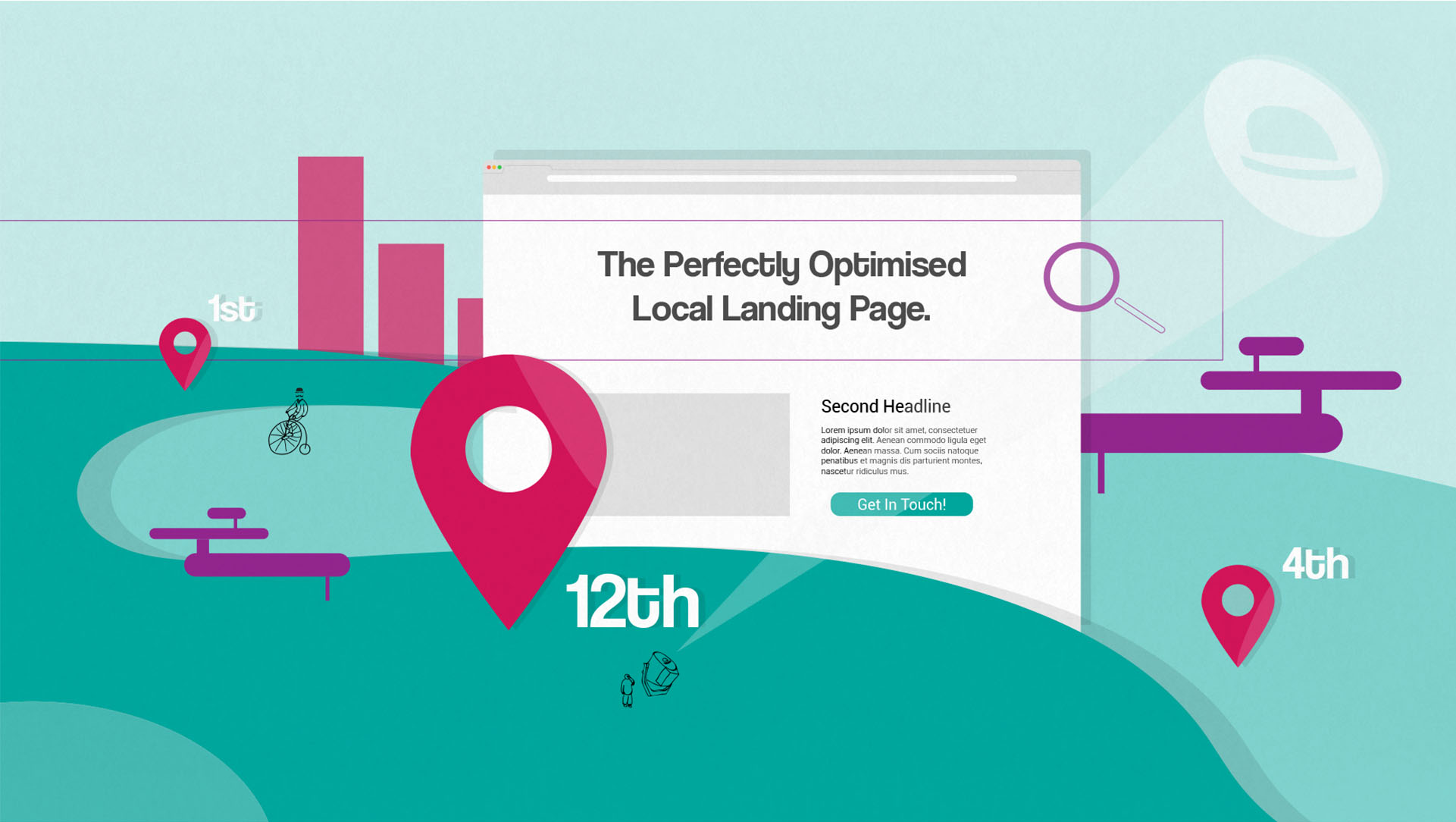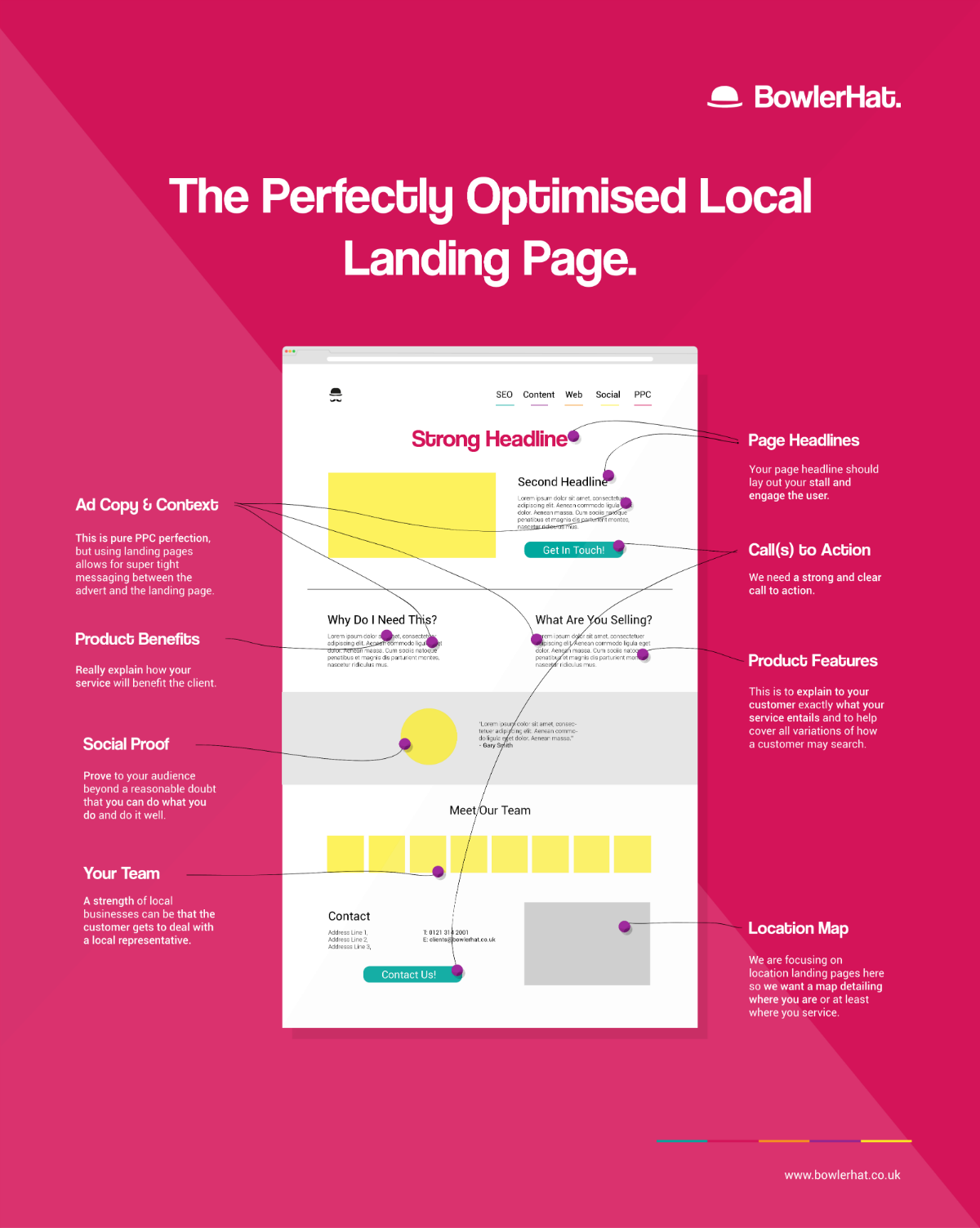
We work with hundreds of local businesses — from hyperlocal, single-location businesses to nationwide, multi-location companies — at the company I run, Bowler Hat.
One pattern we often see is that larger and seemingly more authoritative businesses don’t perform as well in local search as they should. There are many reasons for this, and having multiple locations amplifies the need for solid local SEO foundations. A common issue we come across is the lack of a well-optimized and well-performing landing page for local businesses.
In this post, we aim to illustrate what we believe to be the perfect location landing page, based on our experience working with local businesses.
We must tick our SEO boxes here, but we must also maximize the leads generated from these pages — to do this, we have to look at the intersection of lead generation and local SEO.
Where lead generation meets local SEO
There are two key elements to consider here:
- Local SEO ranking factors
- Landing page conventions
We want to create a perfectly optimized page from a Local SEO perspective but also a finely tuned lead generation machine. These pages should allow the user to achieve their goal — much like a traditional lead-focused landing page.
Clearly, there is some synergy here. To create pages that are highly visible, they should also be highly functional and allow the customer to get in touch and generate us those all important leads.
1. Local SEO ranking factors
Last month, I took a look at the local SEO ranking factors from a recent Moz survey. I wanted to break these down and help local marketers understand what exactly needs to be done to optimize for the primary ranking factors. We can further analyze this information in our quest for the perfectly optimized landing page.
The following are the ranking factors that are relevant for local SEO landing page optimization:
- City, state in landing page title. Easy enough — let’s make sure the page title is optimized!
- Click-through rate from search results. This highlights the importance of relevance and a well-optimized title + meta description.
- Topical keyword relevance of domain content. It might be a challenge to make the whole domain relevant for the keywords you are targeting on a single landing page, especially if you are a multi-location business with separate pages for each location. But you can certainly ensure your whole domain is relevant for the service keywords. If you only have a handful of locations, ensure you mention them on the service pages, or at the very least link to your “our locations†pages on all service pages. Create a clear link between service and location for your users and the search engine.
- Quality/authority of inbound links to landing page URL. This is a given, and if we have a local link, then we should point it to the local landing page. This is only made easier when those landing pages are of a given quality.
- Product/service keyword in landing page title. This is a no-brainer, and the page should be titled for the big terms we want to rank for.
- Page authority of landing page URL. Some authority will be inherited from the site, but often it takes some direct link-building to this page to help move the dial — so the better the page, the easier it is to build those links.
- City, state in landing page H1/H2 tags. This is just more common sense, and if you can mention what you do and where you do it in your landing page header tags (heading or sub-heading), then it will only help with relevancy.
- HTML name, address and phone number (NAP) matching location NAP. More common sense, and if we want Google to trust the address, we should use it consistently on these two key locations.
- Load time of landing page. Slow pages annoy users. Whether this is truly a ranking factor matters not, so keep your page fast and lean so it works well on mobile phones and skinny data connections.
- NAP in hCard/Schema.org on landing page URL. This is really one of those one-percent ranking factors, but if you can mark up the NAP so Google can use it and display it confidently, then it will only help.
- Geographic (city/neighborhood) keyword relevance of domain content. This is really outside the scope of a given landing page, but where possible, consider all the locations where you operate in a sensible way throughout your site. Connect the dots between service pages and location pages with consistent usage of your main locations.
This is not to say every one of these is relevant for every job, but we will want to factor in as many of these as possible in our quest to get the SEO signals dialed in for our landing pages.
2. The perfect landing page
Much of the landing page science comes out of the PPC industry. After all, if you are paying to drive traffic to a given page, then you naturally want to squeeze every last bit of performance from the page. There is no absolutely perfect layout, and the right page is going to very much depend on what is being promoted; however, we can take some guidance from time-tested best practices.
- Ad copy context. This is pure PPC perfection, but using landing pages allows for super-tight messaging between the ad and the page. It certainly does not hurt to consider the context here and the language your users will search with before they hit your page. Align the language and pump up the conversion rate. Local SEO has some parallels, as we are generally quite narrow in the targeting, with keywords and location being the key.
- Page headlines. Your page headline should lay out your positioning and engage the user. A primary headline can often be backed up with a secondary headline. This should be a clear and concise delivery of your unique selling proposition (USP) and value proposition. Let someone know exactly why they should do business with you over the myriad other businesses jostling for their business.
- Product features. We will need to list the specifics of the product or service: exactly what you do. This is to explain to your customer exactly what your service entails and to help cover all variations of how a customer may search. If you are a 24-hour emergency locksmith with no call-out charge, then make sure you detail this on the page.
- Product benefits. This is old school marketing sauce: Detail the features, but extol the benefits of your product or service. Really explain how your service will benefit the client. How you will take away their pain and what they will gain. This is the emotional component to your sales copy which pushes the user to get in touch. Ignore this at your peril.
- Location map. We are focusing on location landing pages here, so we want a map detailing where you are or at least where you service if you don’t have a local address. Ideally, this map should provide driving directions so the user can be guided in.
- Call(s) to action. We need a strong and clear call to action. We want to allow folks to get in touch via a means that best suits them, so a form and a phone number will ensure the best overall results for local business enquiries. I tend to prefer one big CTA (call to action), but we can also use a smaller secondary CTA at the bottom of the page to hoover up those leads for those that traverse the full page length.
- Social proof. We need reviews, testimonials, and even case studies where relevant. Prove to your audience beyond a reasonable doubt that you can do what you do and do it well.
- Your team. A strength of local businesses can be that the customer gets to deal with a local representative. Not a call centre. So, put your team in front of people. Humanise the landing page and show Tom, Dick and Harry from the office who will be answering your call.
The perfectly optimized local landing page
So it naturally follows that the perfect local SEO landing page is also a finely tuned lead generation page. This ticks the boxes for Google, and most importantly, it achieves what your customer is looking for.
To better illustrate this, we have created the following Infographic that shows how you can implement all of these key SEO and landing page elements onto a killer landing page (click to enlarge):
Embed this image on your website using this code:
img src="http://www.ripplesmith.com/wp/wp-content/plugins/rss-poster/cache/607b9_perfectly-optimized-local-landing-page.png"pThe Perfectly Optimized Local Landing Page, by a href="https://www.bowlerhat.co.uk/perfectly-optimised-local-landing-page/"Bowler Hat/a and a href="http://searchengineland.com/"Search Engine Land/a/p
(Note: Feel free to download, use and share this infographic as you see fit, but please drop a credit back to this post or to my site.)
SEO and landing page synergy
It is easy to get trapped in too narrow a perspective — whether that is SEO, PPC, landing page optimization or one of the other myriad digital marketing tactics. My intention here was to illustrate how lessons from one discipline will often complement and improve another.
I would love to see your local landing pages and how you are generating leads from Local SEO traffic, so hit me up on Twitter @MarcusBowlerHat.
Some opinions expressed in this article may be those of a guest author and not necessarily Search Engine Land. Staff authors are listed here.

